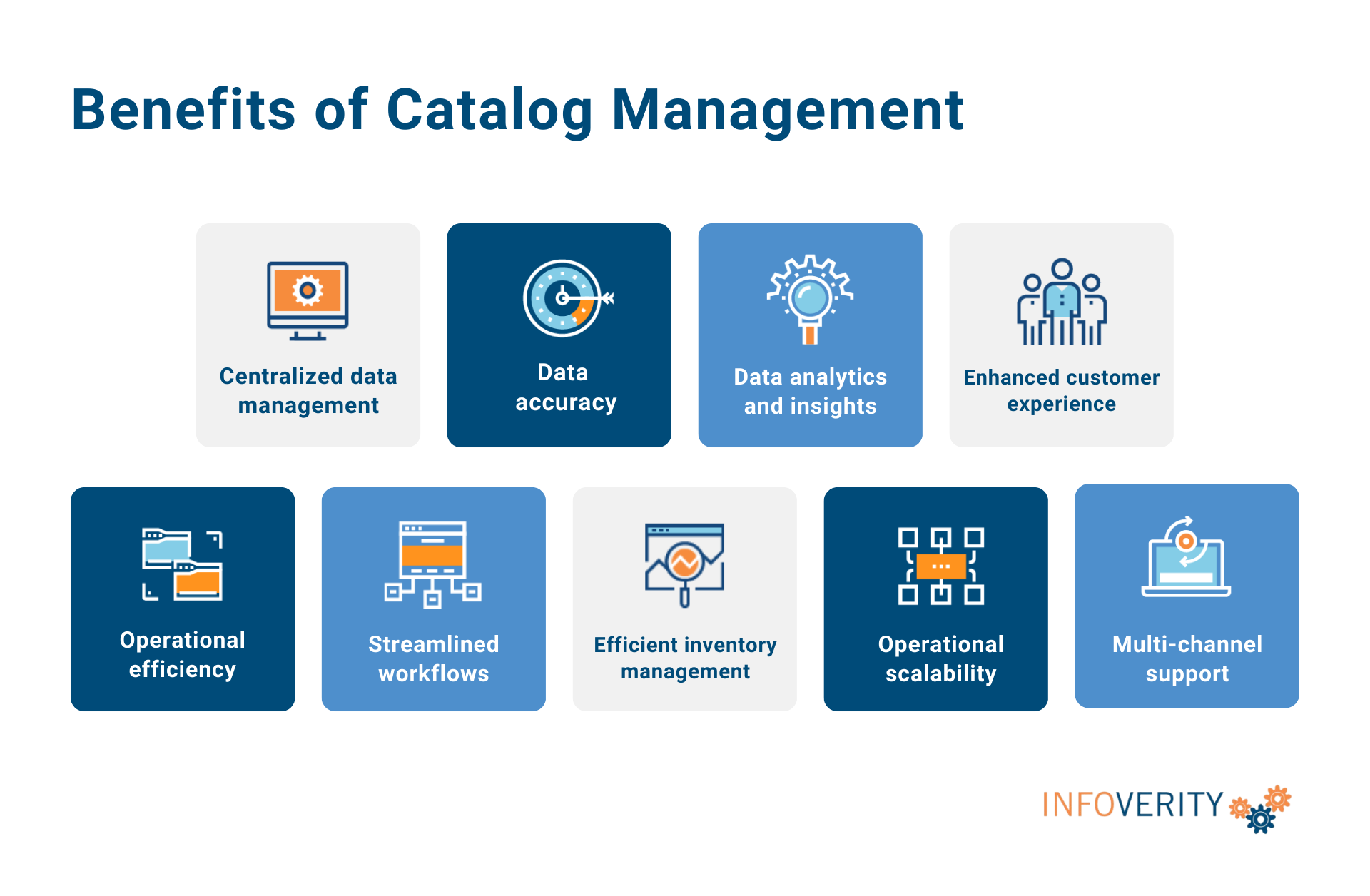Inconsistent product information across channels and departments can undermine customer trust. In fact, only 33% of product managers have a formal product management process. Specifically, this ad-hoc approach can result in inefficient workflows, fragmented data, and missed opportunities for personalization and targeted marketing.
This article covers the definition of catalog management and its benefits. It also outlines specific use cases on how a well-implemented system can drive data accuracy to satisfy customer expectations.
Effective Catalog Management: Table of Contents
What is Catalog Management?
Catalog management is a structured process designed to maintain accurate and consistent product data. Furthermore, the process is designed also to maintain that accuracy across sales channels. In addition, this is a collaborative effort among data managers, product information specialists, IT teams, and C-level executives.
After collecting raw data from multiple sources, the organization must:
- Consolidate raw data, including product descriptions, specifications, images, and pricing, into a centralized system.
- Validate consolidated product data for accuracy and completeness.
- Distribute the validated information by synchronizing updates across e-commerce platforms, mobile apps, and retail systems.
- Monitor and update the catalog in case of discrepancies to maintain reliability across all touchpoints.
Statistics
56% of businesses deploy these systems on-premise, while 44% use cloud-based solutions. Companies with complex operations and large-scale inventory often opt for on-premises systems. In fact, they have in-house servers to store data, offering heightened security measures and compliance.
Meanwhile, third-party infrastructure providers like Amazon Web Services (AWS) and Google Cloud Platform (GCP) host cloud-based catalog management tools. They’re actually more accessible and flexible for e-commerce and businesses with global operations.
9 Benefits of Catalog Management
Organizations use catalog management systems to streamline workflows and enhance the user experience. Effective management helps businesses overcome these challenges and drive success through the following:
Centralized data management
Departments end up with obsolete or conflicting product data if they maintain it on different spreadsheets. Under those circumstances, an up-to-date single source of truth reduces the risk of discrepancies.
Data accuracy
Poor, inaccurate data costs organizations $12.9 million on average. Meanwhile, catalog management centralizes and standardizes product details, reducing inconsistencies and inaccuracies.
Data analytics and insights
Decision-makers only leverage 50% of their available data. Thus, proper management can help unlock the untapped insights for strategic decision-making and product optimization.
Enhanced customer experience
Certainly, 70% of customers expect consistent information from company representatives. All teams—from sales to support—can access the same up-to-date data with centralized product listings.
Operational efficiency
62% of employees waste time searching for information. Thus, catalog management utilizes intuitive search and filtering tools and workflow automation to streamline data access and enhance productivity.
Streamlined workflows
The difficulty in syncing information between systems complicates cross-departmental collaboration. In the meantime, staff can achieve faster responses to market changes and minimize supply chain delays thanks to catalog management.
Efficient inventory management
Well-organized product catalogs have clear, logically categorized information and detailed attribute tagging. Moreover, this structure allows businesses to track inventory levels and optimize stock replenishment.
Operational scalability
Catalog management solutions maintain consistent product data even as businesses scale operations, increase SKUs, or expand into new channels. In the same way, automation reduces the need for large-scale manual updates.
Multi-channel support
48% of companies struggle to create an effective marketing strategy across multiple sales channels. Consequently, systems with multi-channel integration address this by synchronizing product updates and campaigns across websites, mobile apps, and social media.
At this point, businesses strive to remain competitive and responsive to market needs. In fact, catalog management systems help support this new layer of complexity in different business scenarios.

Looking for guidance while managing product catalogs?
Catalog management software prevents data errors and discrepancies, thereby reinforcing customer trust. Manage your product catalogs with Infoverity’s MDM and PIM systems to maintain higher-quality data and deliver better customer experiences. 
Practical Applications
SMEs and enterprises can apply catalog management to improve efficiency, scalability, and growth in various industries. The following use cases demonstrate this:
Multi-Channel Retailing
Data quality (37%) and quantity (27%) challenge multi-channel B2B and B2C businesses. Not to mention different sales platforms displaying varying product pricing or availability. This is a prime example.
To avoid this, catalog management systems automate all product information-related changes in real-time. They can also tailor product feeds and linked media to specific target audiences on different platforms.
Global Expansion and Scalability
Employing advanced systems like Product Information Management (PIM) solutions can help enhance catalog management. Thus, PIM replaces separate, isolated product catalogs, known as multiple product masters (MPMs), for different regions or business units. This transition is crucial for organizations expanding into new markets or operating globally because it supports expansion without disrupting existing operations.
Product Lifecycle Management
Catalog management systems streamline a product’s entire lifecycle. Basically, from its introduction to its eventual phase-out.
- Introduction – centralize and integrate new product information into the database
- Inventory tracking – monitor stock levels and display alerts for low inventory
- Pricing adjustments – support real-time pricing updates across multiple channels
- Marketing and promotions – facilitate consistent product information and messaging
- Phase-out – mark products for clearance and remove outdated information
E-commerce Product Listings
Effective online search relies on precise metadata and hierarchical categorization to deliver relevant results quickly. Indeed, e-commerce platforms require more sophisticated product classification and filtering than physical stores, marketplaces, and other channels.
Thus, e-product catalogs must be equipped with:
- Automatic third-party synchronization to ensure consistency across external sales channels
- ERP and supply chain system integrations to store and maintain accurate product information
- Real-time inventory management and multi-dimensional filtering to optimize online inventory
Effective practices can simplify a company’s operations and strengthen its strategic capabilities. Summing up, investing in smart solutions can facilitate the process for those looking to capitalize on these benefits.
Consistent and High-Quality Data
Catalog management software prevents data errors and discrepancies, thereby reinforcing customer trust. Businesses that leverage these tools can remain competitive while growing at safe, sustainable rates.
Manage product catalogs with Infoverity’s MDM and PIM systems to maintain higher-quality data and deliver better customer experiences. Thus, it facilitates efficient content creation and management by providing a single source of truth for product information.
Contact us to learn more.
FAQ – Catalog management
What is catalog management?
Catalog management is a structured process designed to maintain accurate and consistent product data across sales channels. Furthermore, it’s a collaborative effort among data managers, product information specialists, IT teams, and C-level executives.
What are the benefits of catalog management?
Catalog management streamlines workflows, ensures data accuracy, and enhances the customer experience by centralizing product information. By optimizing inventory management and ensuring scalability, businesses can stay competitive and responsive to market demands.
How catalog management helps an e-commerce?
E-commerce platforms require more sophisticated product classification and filtering than physical stores, marketplaces, and other channels. Specifically, effective online search relies on precise metadata and hierarchical categorization to deliver relevant results quickly.
What are some of the practical applications of catalogue management?
Catalog management enhances efficiency and scalability across industries by ensuring accurate, real-time product data across multiple channels. It supports global expansion with PIM solutions, streamlines product lifecycle management, and optimizes e-commerce listings with automated synchronization and real-time inventory tracking. These smart solutions help businesses stay competitive and improve operational agility.



